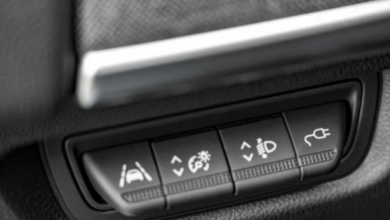
Heat shields are vital components designed to protect various parts of a vehicle, machinery, or other systems from excessive heat. By reflecting, absorbing, or dissipating heat, they ensure that heat-sensitive components remain within safe operating temperatures, thereby preventing damage, enhancing performance, and ensuring safety. In this article, we’ll explore what heat shields are, why they’re important, and the different types of heat shields commonly used in vehicles.
What Are Heat Shields?
A heat shield is a protective barrier that prevents excessive heat from damaging nearby components. They are typically made from materials with high thermal resistance, such as metals, ceramics, or composite materials, which can either reflect heat away, absorb it, or disperse it to reduce the temperature in critical areas.
In vehicles, heat shields are commonly found in the engine bay, around the exhaust system, and in the underbody to protect against the intense heat generated by the engine and exhaust. However, heat shields are not limited to automotive applications; they are also used in aerospace, manufacturing, and electronics to manage heat in various systems.
Types of Heat Shields
There are several types of heat shields, each designed for specific applications and heat management needs. Here’s a closer look at the most common types found in vehicles:
1. Exhaust Heat Shields
Purpose:
Exhaust heat shields are installed around components that generate significant heat, such as the exhaust manifold, catalytic converter, and exhaust pipes. These areas can reach extremely high temperatures, and without proper shielding, the heat could damage surrounding components or even pose a fire hazard.
Material:
Exhaust heat shields are typically made from metals like aluminum or stainless steel due to their ability to withstand high temperatures and resist corrosion. In some cases, they may be coated with ceramic or other heat-resistant materials for added protection.
Function:
These shields reflect heat away from the vehicle’s body, fuel lines, and other heat-sensitive components. They also help maintain the efficiency of the exhaust system by retaining heat within certain areas, which can improve the performance of the catalytic converter.
2. Engine Bay Heat Shields
Purpose:
Engine bay heat shields are designed to protect various components under the hood from the heat generated by the engine. This includes protecting electrical wiring, plastic parts, hoses, and other components that could be damaged or degraded by excessive heat.
Material:
These shields are often made from composite materials or metals with insulating layers to provide effective thermal protection. The materials are chosen for their ability to handle high temperatures and resist the wear and tear caused by the harsh environment of the engine bay.
Function:
Engine bay heat shields help to maintain cooler temperatures for critical components, ensuring that they operate efficiently and have a longer lifespan. They also contribute to the overall thermal management of the vehicle, helping to prevent overheating and improve engine performance.
3. Underbody Heat Shields
Purpose:
Underbody heat shields protect the vehicle’s undercarriage from the heat generated by the exhaust system, particularly in areas where the exhaust runs close to the vehicle’s floor. This is especially important in vehicles with low ground clearance, where the exhaust system is closer to the vehicle’s body.
Material:
These shields are usually made from lightweight metals such as aluminum, which can effectively withstand heat while adding minimal weight to the vehicle. They may also have insulating properties to further reduce heat transfer.
Function:
Underbody heat shields prevent heat from the exhaust from reaching the vehicle’s floor, which can make the cabin uncomfortable and potentially damage components like the fuel tank or brake lines. They also help to dissipate heat away from the vehicle’s undercarriage, reducing the risk of heat-related damage.
4. Turbo Heat Shields
Purpose:
Turbochargers generate significant heat, which can affect surrounding components and reduce the efficiency of the turbo itself. Turbo heat shields are designed to manage this heat, protecting nearby parts and ensuring optimal performance.
Material:
Turbo heat shields are often made from high-temperature resistant metals like stainless steel, and they may be coated with ceramic or other insulating materials to provide extra protection.
Function:
These shields help to contain and manage the heat generated by the turbocharger, preventing it from affecting nearby components such as the air intake, which needs to remain cool for efficient engine performance. By managing heat effectively, turbo heat shields also help improve the overall efficiency and longevity of the turbocharger.
5. Thermal Blankets
Purpose:
Thermal blankets are a type of flexible heat shield that can be wrapped around components to provide thermal insulation. They are commonly used in areas where a rigid heat shield cannot be easily installed or where additional heat protection is needed.
Material:
Thermal blankets are typically made from layers of high-temperature resistant materials, such as fiberglass, silica, or ceramic fibers, with an outer layer of heat-reflective material.
Function:
These blankets provide a flexible solution for heat management, allowing them to be used in tight spaces or wrapped around irregularly shaped components. They are often used on exhaust systems, turbochargers, and other high-heat areas to contain and manage heat more effectively.
Importance of Heat Shields
Heat shields play a critical role in protecting your vehicle from the damaging effects of excessive heat. Here are some of the key reasons why they are important:
- Component Protection: Heat shields prevent heat from reaching and damaging sensitive components like electrical wiring, fuel lines, and plastic parts, which can degrade or fail under high temperatures.
- Improved Performance: By keeping certain areas of the vehicle cool, heat shields help maintain optimal operating conditions for various components, such as the engine and exhaust system. This can lead to better performance and efficiency.
- Safety: Excessive heat can cause fires or other dangerous situations. Heat shields reduce these risks by controlling the spread of heat and preventing it from reaching critical areas.
- Comfort: In vehicles, heat shields help to keep the interior of the car cooler by preventing heat from the engine and exhaust from penetrating the cabin.
- Longevity: By protecting components from heat damage, heat shields help to extend the lifespan of your vehicle’s parts, reducing the need for repairs and replacements.
Conclusion
Heat shields are an essential part of vehicle design, providing critical protection against excessive heat. Whether it’s the exhaust system, engine bay, underbody, or turbocharger, each area of a vehicle that generates significant heat benefits from the use of heat shields. By understanding the different types of heat shields and their functions, you can better appreciate their role in ensuring the safety, performance, and longevity of your vehicle. Regular maintenance and inspection of heat shields are also important to ensure they continue to provide effective protection.




